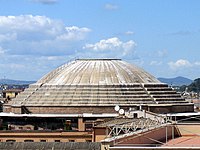
Photo from wikipedia
To take advantage of the road pavement network where non-point source (NPS) pollution such as benzene, toluene, ethyl-benzene, and xylene (BTEX) from vehicle traffic exhaust via wet and dry atmospheric… Click to show full abstract
To take advantage of the road pavement network where non-point source (NPS) pollution such as benzene, toluene, ethyl-benzene, and xylene (BTEX) from vehicle traffic exhaust via wet and dry atmospheric deposition occurs, the asphalt pavement may be used as a media to control the NPS pollution. An experiment to prepare an adsorptive porous reactive pavement (PRP) was initiated to explore the potential to reduce environmental NPS vehicle pollution. The PRP was prepared and studied as follows: various activated carbons (AC) were initially screened to determine if they were suitable as an additive in the porous asphalt mixture; various mixtures of a selected AC were incorporated with the design of porous asphalt concrete (PAC) to produce PRP, and the PRP formulations were tested to ensure that they comply with the required specifications; qualified specimens were subsequently tested to determine their adsorption capacity for BTEX in aqueous solution, as compared to conventional PAC. The PRP08 and PRP16 samples, named for the design formulations of 0.8% and 1.6% of AC (by wt. in the formulation), exhibited low asphalt drain-down and low abrasion loss and also met all regulated specifications. The BTEX adsorption capacity measurements of PRP08 and PRP16 were 33-46%, 36-51%, 20-22%, and 6-8% respectively, higher than those obtained from PACs. Based on the test results, PRPs showed good physical performance and adsorption and may be considered as a potential method for controlling the transport of NPS vehicle pollutants.
Journal Title: Chemosphere
Year Published: 2018
Link to full text (if available)
Share on Social Media: Sign Up to like & get
recommendations!